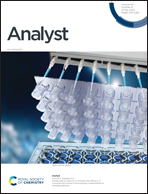Rapid separation of cannabinoid isomer sets using differential mobility spectrometry and mass spectrometry†
Abstract
With legalization and decriminalization of cannabis in many parts of the world comes the need for rapid separation and quantitation of the psychoactive ingredients. Here, we demonstrate the use of differential mobility spectrometry (DMS) mass spectrometry for the analysis of five cannabinoid molecules: the isomer set of Δ9-tetrahydrocannabinol (THC), cannabidiol (CBD), and cannabichromine (CBC), and the (−)-tetrahydrocannabinolic acid (THCA) and cannabidiolic acid (CBDA) isomer pair. Analytes were investigated under a variety of gas-phase environments to identify optimal separation conditions based on ion differential mobilities. Separation of the isomers was complicated by the formation of ion-solvent adducts during electrospray ionization (ESI). The observation of ion-solvent adducts correlated with calculated intermolecular binding energies. Introducing 1.5% (v/v) isopropyl alcohol into the N2 carrier gas resulted in strong clustering with the cannabinoid isomers, displacing ESI solvent from the adducts and enabling separation and quantitation of the cannabinoid isomer sets within seconds. Quantification of the carboxylated isomers in marijuana flower was performed to demonstrate analysis of cannabis samples.



 Please wait while we load your content...
Please wait while we load your content...